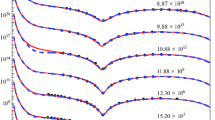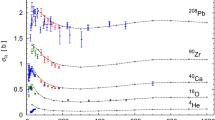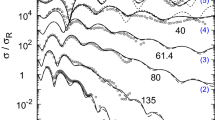Abstract
The nucleon–nucleus optical potential calculated in the Brueckner–Hartree–Fock (BHF) approach is non-local due to exchange and thus requires the solution of an integro-differential equation. We use an alternative approach to show that the exchange part of the central potential can be written as the sum of an infinite series. By using a local approximation, the first term of the series is the Brieva–Rook equivalent local approximation. We consider the first three terms of the series and show that each term of the series can be evaluated without solving the integral equation. We then show, for proton scattering from \(^{40}\hbox {Ca}\) in the energy region \(30 \le E \le 500\) MeV, that the second term contributes less than \(6\% \) to the exchange part of the potential and that the third term is an order of magnitude smaller than the second term. We also show that the addition of the contribution from the second term in the total central potential makes a negligible contribution to the differential cross-section for the scattering of protons from \(^{40}\hbox {Ca}\). Our results thus show that the Brieva–Rook (BR) localisation approximation is accurate to within \(6\%\) in a wide energy region. Our method also provides a qualitative explanation of why the terms beyond the first are so remarkably small and justifies the use of a local approximation. We have also shown that only the direct part of the calculated potential is responsible for the development of the wine-bottle-bottom shape of the real central potential for intermediate energy nucleon scattering.






Similar content being viewed by others
References
B Day, Rev. Mod. Phys. 39, 719 (1967)
K Brueckner and J Gammel, Phys. Rev. 109, 1023 (1958)
M Toyokawa, M Yahiro, T Matsumoto, K Minomo, K Ogata and M Kohno, Phys. Rev. C 92, 024618 (2015); M Toyokawa, M Yahiro, T Matsumoto, K Minomo, K Ogata and M Kohno, Phys. Rev. C 96, 059905 (2017)
F Brieva and J Rook, Nucl. Phys. A 291, 299 (1977); 291, 317 (1977); 297, 206 (1978); 307, 493 (1978)
W Haider, M Sharma, Y Gambhir and S Kailas, Phys. Rev. C 81, 034601 (2010); S Rafi, D Pachouri, M Sharma, A Bhagwat, W Haider and Y Gambhir, Phys. Rev. C 84, 037604 (2011)
N Yamaguchi, S Nagata and T Matsuda, Prog. Theor. Phys. 70, 459 (1983); 76, 1289 (1986)
A Öhrn, J Blomgren, P Andersson, A Ataç, C Gustavsson, J Klug, P Mermod, S Pomp, P Wolniewicz and M Österlund, Phys. Rev. C 77, 024605 (2008)
K Amos, S Karataglidis and J Dobaczewski, Phys. Rev. C 70, 024607 (2004); S Karataglidis, K Amos, B Brown and P Deb, Phys. Rev. C 65, 044306 (2002)
L Rikus, K Nakano and H Von Geramb, Phys. Rev. C 99, 034605 (2019); L Rikus and Von Geramb, Nucl. Phys. A 426, 496 (1984)
T Furumoto, K Tsubakihara, S Ebata and W Horiuchi, Phys. Rev. C 99, 034605 (2019)
M Sharma and W Haider, J. Phys. G 45, 045102 (2018)
M Kohno, Phys. Rev. C 102, 024611 (2020)
H Maridi, Phys. Rev. C 100, 014613 (2019)
Y Kanada-En’yo and K Ogata, Phys. Rev. C 99, 064601 (2019); 99, 064608 (2019); 100, 064616 (2019)
K Egashira, K Minomo, M Toyokawa, T Matsumoto and M Yahiro, Phys. Rev. C 89, 064611 (2014)
T Furumoto, W Horiuchi, M Takashina, Y Yamamoto and Y Sakuragi, Phys. Rev. C 85, 044607 (2012)
M Toyokawa, K Minomo and M Yahiro, Phys. Rev. C 88, 054602 (2013)
S Rafi, A Bhagwat, W Haider and Y Gambhir, Phys. Rev. C 86, 034612 (2012); M Sharma, A Bhagwat, Z Khan, W Haider and Y Gambhir, Phys. Rev. C 83, 031601 (2011); M Sharma, W Haider and A Bhagwat, J. Phys. G 44, 105107 (2017)
S Karataglidis and K Amos, Phys. Rev. C 87, 054623 (2013); K Amos, P Dortmans, H Von Geramb, S Karataglidis and J Raynnal, Advances in nuclear physics (Springer, 2002) pp. 276–536
R Wiringa, V Stoks and R Schiavilla, Phys. Rev. C 51, 38 (1995)
R Machleidt, F Sammarruca and Y Song, Phys. Rev. C 53, R1483 (1996)
V Stoks, R Klomp, C Terheggen and J De Swart, Phys. Rev. C 49, 2950 (1994)
S Rafi, M Sharma, D Pachouri, W Haider and Y Gambhir, Phys. Rev. C 87, 014003 (2013); S Saliem and W Haider, J. Phys. G 28, 1313 (2002)
M Vorabbi, M Gennari, P Finelli, C Giusti, P Navrátil and R Machleidt, Phys. Rev. C 103, 024604 (2021)
M Kamimura, M Yahiro, Y Iseri, Y Sakuragi, H Kameyama and M Kawai, Prog. Theor. Phys. Suppl. 89, 1 (1986)
S Sakaguchi et al, Phys. Rev. C 84, 024604 (2011)
M Toyokawa, T Matsumoto, K Minomo and M Yahiro, Phys. Rev. C 91, 064610 (2015)
K Minomo, K Ogata, M Kohno, Y Shimizu and M Yahiro, J. Phys. G 37, 085011 (2010)
W Haider, S Rafi, J Rook and Y Gambhir, Phys. Rev. C 93, 054615 (2016)
K Hagino, T Takehi and N Takigawa, Phys. Rev. C 74, 037601 (2006)
B Friedman and V Pandharipande, Phys. Lett. B 100, 205 (1981)
L lton, Nucl. Phys. 89, 69 (1966)
P Schwandt, AIP Conf. Proc. No. 97. pp. 89 (1983); L Arnold, B Clark, R Mercer and P Schwandt, Phys. Rev. C 23, 1949 (1981)
G Satchler, Nucl. Phys. A 394, 349 (1983); M Hemalatha, Y Gambhir, S Kailas and W Haider, Phys. Rev. C 75, 037602 (2007)
L Kisslinger, Phys.Rev. 98, 761 (1955)
C Mahaux and R Sartor, Nuclear structure edited by R Broglia, G Hagemann and B Herskind (Elsevier, 1985) pp. 45–56
Y Gambhir, A Bhagwat and M Gupta, Ann. Phys. 320, 429 (2005)
B Ridley and J Turner, Nucl. Phys. 58, 497 (1964)
D Hutcheon et al, Nucl. Phys. A 483, 429 (1988)
G Lalazissis, J König and P Ring, Phys. Rev. C 55, 540 (1997)
G Lalazissis, S Karatzikos, R Fossion, D Arteaga, A Afanasjev and P Ring, Phys. Lett. B 671, 36 (2009)
G Lalazissis, T Niksic, D Vretenar and P Ring, Phys. Rev. C 71, 024312 (2005)
Acknowledgements
The authors would like to thank Prof. Y K Gambhir for his interest in the work. W Haider is thankful to Prof. Q N Usmani and Prof. Vijay Sharma for several useful suggestions. S Rafi acknowleges the facilities provided by Higher Education Department Jammu and Kashmir.
Author information
Authors and Affiliations
Corresponding author
Appendices
Appendix A
The total central nucleon–nucleus potential up to the third term in the expansion of the exchange term [eq. (25)] is of the form:
where \(U_{\textrm{Dir}}(\textbf{r}_{\textbf{1}})\) is the direct part of the central potential and \(A(\textbf{r}_{\textbf{1}}),b(\textbf{r}_{\textbf{1}})\) and \(c(\textbf{r}_{\textbf{1}})\) are defined respectively in eqs (14), (19) and (24). The Schrödinger equation for the incident particle satisfying scattering boundary conditions is
where \(V(r _1) = U_{\textrm{Dir}}(\textbf{r}_{\textbf{1}})+A(\textbf{r}_{\textbf{1}})\).
We can absorb the last \(\nabla _1^2\) term (see eq. (A.1)) in the kinetic energy part of eq. (A.2) and rewrite it as
where we have defined the effective mass [36]
In the following, we drop any consideration of the third term, involving \(c(\textbf{r}_{\textbf{1}}) \) in the expansion of the exchange term, then we can take \(m^{*}=m\). However, the procedure outlined below can be easily extended to include the effect of the third term, as shown in Appendix B, when all the three terms are included in the Schrödinger equation. The Schrödinger equation for the incident particle satisfying the scattering boundary conditions to be solved then is,
We take \(\Psi (\textbf{r}_{\textbf{1}})\) to be a product of two functions, i.e.,\(\Psi (\textbf{r}_{\textbf{1}})=\varphi (\textbf{r}_{\textbf{1}})\chi (\textbf{r}_{\textbf{1}})\), where we take \(\chi (\textbf{r}_{\textbf{1}})\) to be a function of \(|\textbf{r}_{\textbf{1}}|\) only. We can then rewrite (A.4) as
The differential operators in (A.5) can be written as follows:
Since \(\chi (\textbf{r}_{\textbf{1}})\) is a function of \(|\textbf{r}_{\textbf{1}}|\) only, we can write
where \(\hat{\textbf{r}_{\textbf{1}}}\) is a unit vector. We can then write
Finally, we get
Substituting (A.6) and (A.8) in (A.5) we obtain the following equation:
Rearranging various terms in the above equation we can write
We can choose \(\chi (\textbf{r}_{\textbf{1}})\) such that the expression in the curly brackets, in (A.10), vanishes. This gives us
\(b(\textbf{r}_{\textbf{1}} )\) [see eq. (19)] is an integration of the effective interaction over the densities, which approaches zero as \(\textbf{r}_{\textbf{1}}\) becomes larger than the nuclear radius. This implies that \(\chi (\textbf{r}_{\textbf{1}}) \rightarrow \) constant as r is much greater than nuclear radius. Thus, \(\chi (\textbf{r}_{\textbf{1}})\) would determine only the size of the wave function. Hence, the phase shifts would be determined by the asymptotic behaviour of only the wave function \(\varphi (\textbf{r}_{\textbf{1}})\). Using (A.11) we can write
Using (A.12) and (A.13) in (A.10) gives us the following equation:
We can eliminate \(\chi (\textbf{r}_{\textbf{1}})\) in (A.14), as it is never zero or infinite, and finally obtain the following equation for the function \(\varphi (\textbf{r}_{\textbf{1}})\):
Thus, the inclusion of the second term in the expansion of the exchange part of the potential implies the following additional term, denoted as \(\hbox {CST}(\textbf{r}_{\textbf{1}})\), in the local central optical potential describing \(\varphi (\textbf{r}_{\textbf{1}})\), which gives the same phase shifts as the full wave function \(\Psi (\textbf{r}_{\textbf{1}})\).
The procedure outlined above can be easily extended to higher-order terms in our expansion of the exchange part of the optical potential.
Appendix B
In the following, we extend the procedure outlined in Appendix A for including the effect of the third term in our expansion of the exchange term of the nucleon–nucleus optical potential. If we include the first three terms in our expansion, then the Schrödinger equation to be solved for the scattering of nucleon from a nucleus is (see (A.3)):
where the effective mass \(m^*\) is defined as
As in Appendix A, we write the total wave function as the product of two functions: \(\Psi (\textbf{r}_{\textbf{1}})=\varphi (\textbf{r}_{\textbf{1}})\chi (\textbf{r}_{\textbf{1}})\), where \(\chi (\textbf{r}_{\textbf{1}})\) is taken as a function of \(|\textbf{r}_{\textbf{1}}|\) only. Using (A.6) and (A.8) we can write
and eq. (A.8) gives us
Using (B.2) we can write
Using (B.2), (B.3) and (B.4) in (B.1) and rearranging we get
We can choose \(\chi (\textbf{r}_{\textbf{1}})\) such that the term in the curly brackets of (B.5) vanishes. Then
Integrating the above, we obtain
As discussed in §2.3, since \(c(\textbf{r}_{\textbf{1}})\) is several orders of magnitude smaller than \({\hbar ^2}/{m,}\) we can safely assume \(m^{*}\sim m\), and the denominator in the integrand of eq. (B.7) would never vanish. Further, as discussed in Appendix A, the phase shifts of the scattered particle would be determined only by the asymptotic behaviour of \(\varphi (\textbf{r}_{\textbf{1}})\). Here, we are neglecting \(c(r')\) in the denominator of (B.7) only as it is negligible compared to \({\hbar ^2}/{m^{*}}\).
Substituting (B.7) in (B.5) and eliminating \(\chi (\textbf{r}_{\textbf{1}})\), as it is only a multiplicative factor, we obtain the following equation for \(\varphi (\textbf{r}_{\textbf{1}})\):
Thus, the total exchange nucleon–nucleus potential describing \(\varphi (\textbf{r}_{\textbf{1}})\), when the first three terms in our expansion are considered, is
Rights and permissions
About this article
Cite this article
Haider, W., Rafi, S., Rook, J.R. et al. Brieva–Rook approximation for the central exchange potential revisited. Pramana - J Phys 97, 61 (2023). https://doi.org/10.1007/s12043-023-02537-w
Received:
Revised:
Accepted:
Published:
DOI: https://doi.org/10.1007/s12043-023-02537-w
Keywords
- Nucleon–nucleus optical potential
- Brueckner–Hartree–Fock approach
- Brieva–Rook equivalent local approximation




